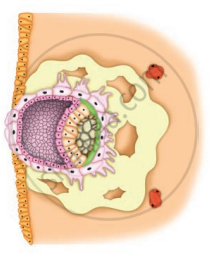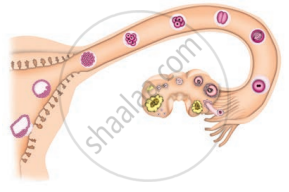Advertisements
Advertisements
प्रश्न
Observe the following figures.
 |
 |
 |
|
| (a) | (b) | (c) | (d) |
- Identify the stages (a) to (d) in figure during development of human baby.
- Arrange the stages in correct sequence of development.
- Explain the development that takes place in any one stage.
उत्तर
- The figures showing stages during development of embryo are identified as -
(a) Embedding of the embryo in the uterus (implantation).
(b) Fertilisation (fusion of egg and sperm).
(c) Stages in development of an embryo from the zygote in the oviduct, till it gets embedded in uterus.
(d) Zygote (showing fusion of nuclei) - The above stages in sequence are :
(b) Fertilisation → (d) Zygote formation → (c) Development of embryo → (a) Implantation of embryo in uteras. - Development of embryo The embryo after being implanted in uterus, continues to develop and divide and differentiate into body parts. The stage of embryo when body parts become distinct and identified is called foetus. After complete development of foetus, mother gives birth to baby.
APPEARS IN
संबंधित प्रश्न
What is DNA?
What is DNA copying?
Explain the importance of reproduction in organisms.
What is a clone? Why do offsprings formed by asexual reproduction exhibit remarkable similarity?
Match the organisms given in column I with the methods of reproduction/propagation given in column II :
| Column I | Column II | |
| (i) Plasmodium | (a) Spore formation | |
| (ii) Spirogyra | (b) Leaves | |
| (iii) Jasmine | (c) Regeneration | |
| (iv) Apple tree | (d) Budding | |
| (v) Bryophyllum | (e) Binary fission | |
| (vi) Potatoes | (f) Layering | |
| (vii) Rhizopus | (g) Fragmentation | |
| (viii) Hydra | (h) Tubers | |
| (ix) Planaria | (i) Cuttings | |
| (x) Leishmania | (j) Multiple fission | |
| (xi) Sugar cane | (k) Grafting | |
| (xii) Rose |
What are the two general methods of reproduction in organisms?
The protozoan having a flagellum at its one end is :
(a) Amoeba
(b) Paramecium
(c) Hydra
(d) Leishmania
In the list of organisms given below, those which reproduce by the asexual method are :
(i) banana
(ii) yak
(iii) yeast
(iv) Amoeba
(a) (ii) and (iv)
(b) (i), (iii) and (iv)
(c) (i) and (iv)
(d) (ii), (iii) and (iv)
Why is reproduction necessary for living organisms?
Differentiate between the following:
Asexual reproduction and sexual reproduction.
List any two different forms asexual reproduction.
Explain the role of DNA in the process of reproduction of the cell.
By which process do green plants synthesize their food?
Multiple choice question.
The ploidy level is not the same in ______.
Which of the following types require pollinator but the result is genetically similar to autogamy?
In vitro pollen germination and pollen tube elongation can be induced by ______.
Self-incompatibility is found in flowers of plants _______.
The example of dicot endospermic seed is ______.
What is the use of tablet ‘Saheli’?
Identify the chromosome number of the endosperm in the following case. In an angiosperm a female plant having 2n = 24 is crossed with a male plant having 2n = 12.

